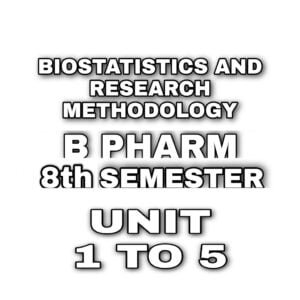Imperfect Pharmacy
B Pharmacy
Notes
8th Semester
BIOSTATISTICS AND RESEARCH METHODOLOGY
Unit 1Introduction: Statistics, Biostatistics, Frequency distribution
Measures of central tendency: Mean, Median, Mode- Pharmaceutical examples
Measures of dispersion: Dispersion, Range, standard deviation, Pharmaceutical problems
Correlation: Definition, Karl Pearson’s coefficient of correlation, Multiple correlation – Pharmaceuticals examples
Unit 2
Regression: Curve fitting by the method of least squares, fitting the lines y= a + bx and x = a + by, Multiple regression, standard error of regression – Pharmaceutical Examples
Probability: Definition of probability, Binomial distribution, Normal distribution,
Poisson’s distribution, properties – problems
Sample, Population, large sample, small sample, Null hypothesis, alternative hypothesis, sampling, essence of sampling, types of sampling, Error-I type, Error-II type, Standard error of mean (SEM) – Pharmaceutical examples
Parametric test: t-test(Sample, Pooled or Unpaired and Paired) , ANOVA, (One way and Two way), Least Significance difference
Unit 3
Non Parametric tests: Wilcoxon Rank Sum Test, Mann-Whitney U test, Kruskal-Wallis test, Friedman Test
Introduction to Research: Need for research, Need for design of Experiments, Experiential Design Technique, plagiarism
Graphs: Histogram, Pie Chart, Cubic Graph, response surface plot, Counter Plot graph
Designing the methodology: Sample size determination and Power of a study, Report writing and presentation of data, Protocol, Cohorts studies, Observational studies, Experimental studies, Designing clinical trial, various phases.
Unit 4
Blocking and confounding system for Two-level factorials
Regression modeling: Hypothesis testing in Simple and Multiple regressionmodels
Introduction to Practical components of Industrial and Clinical Trials Problems: Statistical Analysis Using Excel, SPSS, MINITAB®, DESIGN OF EXPERIMENTS, R – Online Statistical Software’s to Industrial and Clinical trial approach
Unit 5
Design and Analysis of experiments:
Factorial Design: Definition, 2², 2³ design. Advantage of factorial design
Response Surface methodology: Central composite design, Historical design, Optimization Techniques


